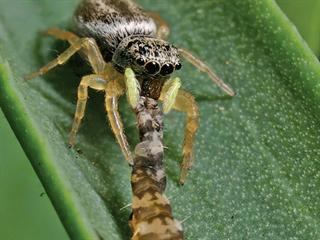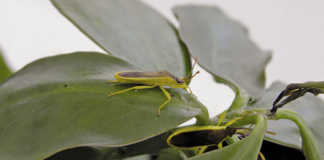
It has long been known that spiders are highly effective insect predators. Uniquely specialised, they have evolved to exploit virtually every niche, and their diet includes a huge variety of insects. In South Africa, this includes most of the harmful pest species – good news for farmers.
A growing body of research has shown that spiders may be even more effective as natural control agents in crops and orchards than believed up till now. Dr Dippenaar-Schoeman, a specialist at the Agricultural Research Council’s Plant Protection Research Institute (ARC-PPRI), explains: “Although one single spider species may not be able to control pests, a conglomerate of spiders is a valuable tool to stabilise pest populations and keep these at endemic levels early in the season.
They can also prevent or prolong outbreaks from occurring in the first place.” One of the reasons for their effectiveness is the fact that they prey on pests at all of the insects’ life stages – eggs, larvae, pupae and moths.

Dr Ansie Dippenaar-Schoeman. Photo courtesy of the ARC
Variety – key to success
“The spider research unit at the ARC-PPRI has been involved in research on spiders in various agro-ecosystems and orchards for the last 40 years,” says Dr Dippenaar-Schoeman. In one of the studies, more than 5 000 spiders representing 127 species from 31 families were collected from one crop type alone – cotton. This range of species helps to explain why the spiders were able to target a wide range of pests, including mites, aphids, leaf hoppers, bollworm moths and larvae. In fact, the spiders represented about 70% of all predators in the cotton.
In another study, 5 059 spiders of 32 species were collected from strawberry lands. The most abundant species among these was the wolf spider (Pardosa crassipalpis), which preys mainly on red spider mites. In a 25-year study, the ARC sampled 10 sites in citrus-growing areas collecting 198 species from 35 families. It was found that they targeted pests such as thrips, citrus scale and citrus psylla.
“Macadamia orchards in Mpumalanga were also sampled,” says Dr Dippenaar-Schoeman. “More than 2 770 spiders representing 80 species were collected in these orchards. Jumping spiders (Salticidae) accounted for 73% of all the spiders collected. These fed on pests such as thrips, mites, midges and flies. And in avocado orchards, we collected 3 715 specimens – 90 species in all. Jumping spiders made up 31% of the total, followed by crab spiders (Thomisidae) – 24%. The latter prey on small pests such as aphids, red spider mites and thrips.”
Built to hunt, kill and eat
A study of the spider’s adaptations shows why it is such an effective predator, explains Dr Dippenaar-Schoeman. It has a soft, extensible abdomen, enabling it to eat large amounts of food in a short time. It can lower its metabolic rate, allowing it to withstand harsh weather and survive hunger during periods of low pest numbers, such as early in the season. And most species prey on several types of insects, enabling them to take advantage of food when it becomes available.

Crab spiders feed on locusts, one of the most voracious crop pests. Photo by Johan Gerber
“There are about 2 000 known spider species in South Africa. Spiders are usually divided into wandering and web-building types. Different species have different hunting strategies and are found in many habitats,” says Dr Dippenaar-Schoeman. “They even occupy different habitats within a single crop, which gives them access to virtually all pest species. An added bonus for farmers is that spiders are distributed efficiently by ballooning in the wind.
This is the main way in which they colonise cultivated lands.” Dr Dippenaar-Schoeman stresses that spiders are superb biological control agents and as such are “a farmer’s best friend”. But the extent to which they can contribute to pest control can be limited by insecticide. The following good spraying practices can help to conserve spider populations:
- Spraying selectively and in limited quantity can prevent harm to spiders and other insect predators. In particular, applying pesticides as spot treatments will allow spiders to recolonise treated areas rapidly.
- Restricting spraying early in the season will allow spiders to restrict pest populations from the start.
- Limiting spraying to midday when spiders are less active.
Some farmers even use spider numbers as an indicator of spraying levels. A low spider population can signal that insecticide has been over-applied.
Contact Dr Ansie Dippenaar-Schoeman on 012 808 8247 or [email protected].













